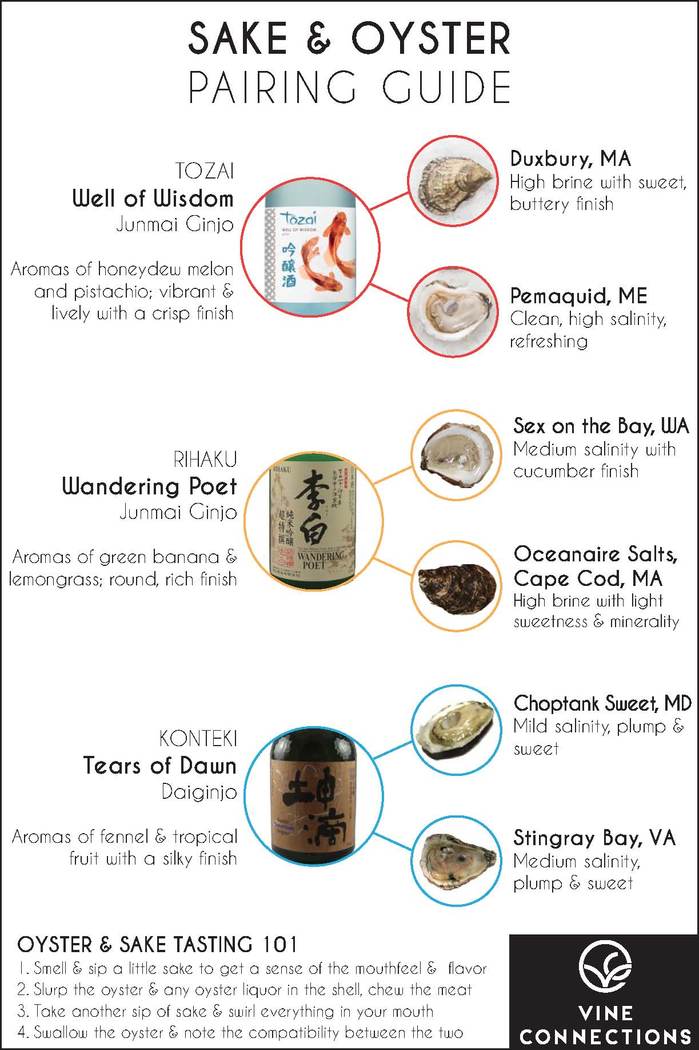| December 2015 | ||
| « Nov 2015 | News | Jan 2016 » |
December 17, 2015
Art + Science: The Living Wines Collective
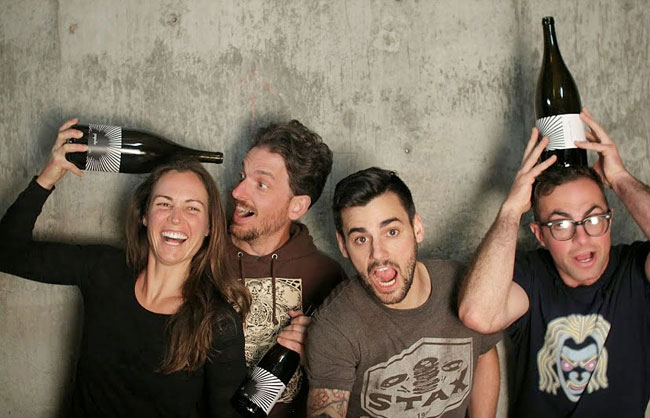
We talk a lot about technique and a lot about terroir in winemaking, but it’s hard to replace the pure, raw electricity of people passionate about their work. The Living Wines Collective from Orinda, California, has technique and terroir in spades, but what most impressed me about this gang of four buddies is their passion for what they do. Perhaps that’s owed to the project they’ve assembled: a kind of winemaker’s utopia, where friends “share all of the work, expenses, profits and fun.” These four—Martha Stoumen, Diego Roig, Sam Baron, and Shaunt Oungoulian—make kick-ass natural wines together, each helping the group while exploring individual winemaking interests. The idea isn’t new—there have been winemaking co-ops in Europe for centuries—but their perspective encapsulates contemporary California: bringing cutting-edge technological know-how to old-school natural winemaking; prioritizing community; making honest wines that are meant to be drunk at the table every single day (and charging prices to match).
The four met in winemaking school at UC Davis, then traveled the world to apprentice with some of the most exciting winemakers working today (e.g., Giusto Occhipinti, Didier Barral, Philippe Valette, Chris Brockway). Years later, they reconvened in Northern California to pool their resources and make good juice. Throw in an empty (and huge) basement at Shaunt’s parents’ house, and you’ve got yourself a full-fledged winery, with both the technical chops and the experience to produce really great wine right out of the gate. I talked with Shaunt, who explained how it came to be: “We each wanted to make wine, but none of us individually had the resources to get a project going ourselves. I had a space, Sam had a lot of connections and Diego and Martha brought some capital. We jackhammered the floor to install our own drains, did our own electric work, scraped together the bare minimum of equipment, and found ourselves in the fortunate position of owning our own winery with complete freedom to make wine however we best saw fit.”
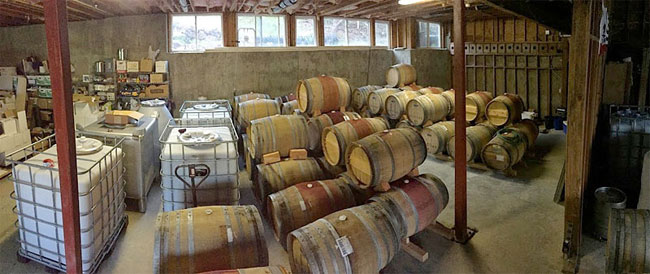
That freedom has been crucial in maintaining their commitment to natural wine while keeping costs low. They source from organic vineyards off the beaten path. They work meticulously in the vineyard—just get them started on the topic of pruning!—so that they can intervene minimally in the cellar. They never add sulfur at the crush pad to avoid discouraging any indigenous yeasts (and use only minimal sulfur later in the process). “Really, what we’re trying to do is to bridge the gap between the vineyard and the winemaker and bring a more European approach to winemaking in California. By controlling the farming, we know exactly what is happening at every step of the process and can transmit this information to our customers. We are 100% transparent in our work, and we would hope that others would follow suit. When you are forthcoming and are willing to tell your customers about every input in your vineyard or wine, you will avoid putting poisons down. That would be an awkward conversation to have,” says Shaunt.
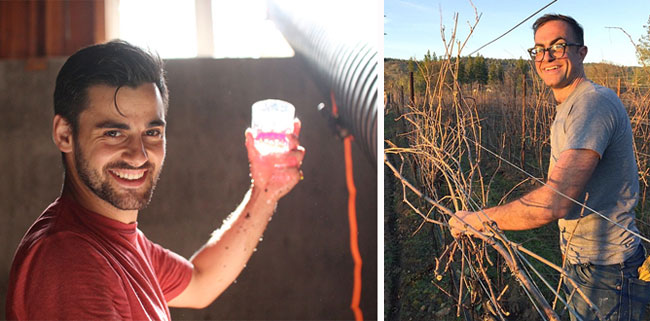
Their quest for the right vines has taken them to Manton Valley, a brand-new AVA (as of 2014) with a town that, according to Wines & Vines, “boasts a population of 347, a diner, a bar, no gas station and a handful of wineries and tiny vineyards that thrive in its volcanic soils.” (08/2014) It’s in the foothills of Mt. Lassen, an active volcano on the southernmost tip of the Cascade Mountain range. And it appears to be one of California’s best-kept secrets: high elevation, amazing volcanic and sandy soils, a continental climate thanks to its interior position in the state. The vineyard they work with, Dobson, has Chardonnay vines planted in 1972 that are still on their own roots. It’s this special corner of California where they’ve chosen to plant their own vineyard. Says Shaunt: “It’s really great to be working in a region that is a bit more off the beaten path. There’s a lot less financial pressure influencing decisions. In Napa and Sonoma, the sites are ripped, irrigation lines are installed, and the vines are pushed to be in full production by their third year. We’re taking a slower approach and establishing the vineyard to be dry-farmed. In the first year we have to water each vine by hand a few times during the season, but in the second and third year, one pulls back a bit with the irrigation, encouraging the roots to go deep and find their own water. Establishing a vineyard like this, one that doesn’t rely on external water sources, takes about 6 years to reach production. But we think that it’s worth it to put in the time and effort now. All the old vine vineyards that one finds throughout California were established like this. We’re hoping to plant this vineyard not only for ourselves, but for future generations as well.”
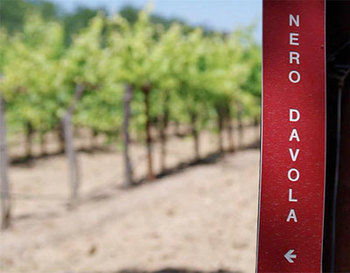 The Living Wines Collective is comprised of three labels: Ama Cellars, Les Lunes, and Populis. Ama Cellars wines are made by Martha and Diego, who were inspired by their time in Italy to find Nero D’Avola in California. They struck gold in Mendocino County at Fox Hill Vineyard, one of the very few in the U.S. that grows this native Sicilian grape. The 2014 Ama Cellars Nero D’Avola is a deep blue-violet-colored wine, with aromas of black cherry, blackberry, raspberry, sage, and leather on the nose. It develops steadily in the glass and offers notes of cherry cordial on the palate. It’s medium weight, with a nice grip and lively acidity—perfect for food. This seductive and dark elixir finishes on a note of blackberry, and just cries out to be eaten with tomatoes. Try going Italo-Cali with a tomato tart.
The Living Wines Collective is comprised of three labels: Ama Cellars, Les Lunes, and Populis. Ama Cellars wines are made by Martha and Diego, who were inspired by their time in Italy to find Nero D’Avola in California. They struck gold in Mendocino County at Fox Hill Vineyard, one of the very few in the U.S. that grows this native Sicilian grape. The 2014 Ama Cellars Nero D’Avola is a deep blue-violet-colored wine, with aromas of black cherry, blackberry, raspberry, sage, and leather on the nose. It develops steadily in the glass and offers notes of cherry cordial on the palate. It’s medium weight, with a nice grip and lively acidity—perfect for food. This seductive and dark elixir finishes on a note of blackberry, and just cries out to be eaten with tomatoes. Try going Italo-Cali with a tomato tart.
Les Lunes is made by Shaunt and Sam with an eye toward the great wines of California’s past. The 2014 Dobson Vineyard Chardonnay is electrifying and complex, a completely interesting and delicious wine that reminds me of a Santorini. All of the Living Wines reach full malolactic fermentation, and there’s certainly weight here—a full-figured palate. But the acid is so bright that it retains vitality throughout. The nose opens with bright stone fruits, lemon, and apple, then exhibits a slightly oxidative quality, with just a touch of walnut oil. This is a wine that develops considerably while drinking, and what really picks up speed is the minerality and chalky stoniness. The volcanic soil here is clearly transmitted in the glass, and the result is fascinating.
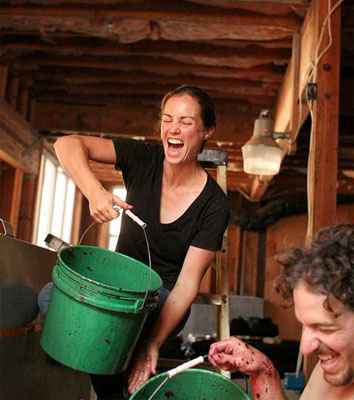 Populis is the label that they all work on together, and, as you might expect, it is for the people by the people. These are seriously made wines, but priced for good, solid, everyday drinking. The 2014 Populis Carignane is sourced from organically dry-farmed 67-year-old vines in Mendocino County. It is juicy and lipsmackingly drinkable. Aromatics of dried cranberry, currant, raspberry, and a touch of game lead to a flirty, juicy palate then a dry finish. The acid brings a buoyancy that makes this wine just plain fun.
Populis is the label that they all work on together, and, as you might expect, it is for the people by the people. These are seriously made wines, but priced for good, solid, everyday drinking. The 2014 Populis Carignane is sourced from organically dry-farmed 67-year-old vines in Mendocino County. It is juicy and lipsmackingly drinkable. Aromatics of dried cranberry, currant, raspberry, and a touch of game lead to a flirty, juicy palate then a dry finish. The acid brings a buoyancy that makes this wine just plain fun.
Shaunt attributes much of their success to the power inherent in a collective: “The collective nature of the project is letting us take on projects that would be impossible any other way. The fact that we own our own space and equipment and that we don’t have any investors (aside from ourselves) gives us the freedom to make wine in ways normally not possible for young start-up wineries. For instance, in 2014 we produced about 2,000 cases of wine, but only bottled about 800 of them. The rest is being over vintaged for one or more years. There are a lot of examples of low-intervention wines being made in California, but most of them are made in very fresh and primary styles. We’re hoping to make a number of wines, still in the low intervention style, that are a bit more ‘serious’ and age-worthy. This is really only possible with the collective nature of our project. It’s pretty crazy to be in our cellar right now, we’ve got a lot of wine down there and the ‘14’s are starting to pick up some nice secondary flavors. We’re really excited with how things are turning out.” And it is exciting—to watch this new project take off, full of zest and energy and vision—not to mention undeniably delicious wines.
Written by Kate Soto

